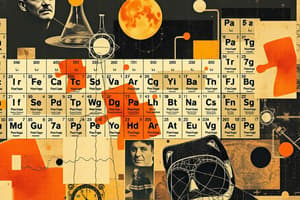Podcast
Questions and Answers
What is the trend of atomic size as you move from left to right across a row in the periodic table?
What is the trend of atomic size as you move from left to right across a row in the periodic table?
- It decreases (correct)
- It increases
- It fluctuates
- It remains the same
What does electronegativity refer to in the periodic table?
What does electronegativity refer to in the periodic table?
- Tendency of an atom to lose electrons
- Tendency of an atom to attract electrons to itself (correct)
- Tendency of an atom to form positive ions
- Tendency of an atom to resist chemical reactions
What is ionization energy in the context of the periodic table?
What is ionization energy in the context of the periodic table?
- Energy released when an atom forms a bond
- Energy released when an atom gains an electron
- Energy required to form a chemical compound
- Energy required to remove an electron from an atom or ion (correct)
What happens to metallic character as you move from left to right across a row in the periodic table?
What happens to metallic character as you move from left to right across a row in the periodic table?
Where are the more electron-rich elements found on the periodic table?
Where are the more electron-rich elements found on the periodic table?
How do electronegativity trends in the periodic table behave as you move down a group?
How do electronegativity trends in the periodic table behave as you move down a group?
Study Notes
Modern Periodic Table
The modern periodic table is a tabular arrangement of chemical elements, organized based on their atomic structures and properties. It provides a comprehensive understanding of the elements and their relationships with one another.
Periodic Trends
The periodic trends refer to the recurring patterns observed in the properties of elements as they arrange in the periodic table. These trends include:
-
Atomic size: As you move from left to right across a row in the periodic table, the atomic size decreases, as atoms lose electrons and become more positively charged.
-
Electronegativity: This is the tendency of an atom to attract electrons to itself. Electronegativity trends in the periodic table show that electronegativity tends to increase as you move from left to right and down a group.
-
Ionization energy: This is the energy required to remove an electron from an atom or ion. Trends show that ionization energy increases as you move down a group in the periodic table.
-
Metallic character: Metallic character is the tendency of an element to form positive ions. Generally, the more electron-rich elements are found on the left side of the periodic table, while the more electron-poor elements are found on the right side.
-
Reactivity: Reactivity trends show that reactivity generally increases as you move down a group in the periodic table.
-
Metalloid character: Metalloids are elements that lie between metals and non-metals on the periodic table. They have properties of both metals and non-metals, such as conductivity and poor conductivity, respectively.
These periodic trends help chemists and scientists understand the properties of elements and predict their behavior under different conditions.
Studying That Suits You
Use AI to generate personalized quizzes and flashcards to suit your learning preferences.
Description
Explore the modern periodic table and learn about the periodic trends which include atomic size, electronegativity, ionization energy, metallic character, reactivity, and metalloid character. Understand how these trends help in predicting the behavior of elements under different conditions.




